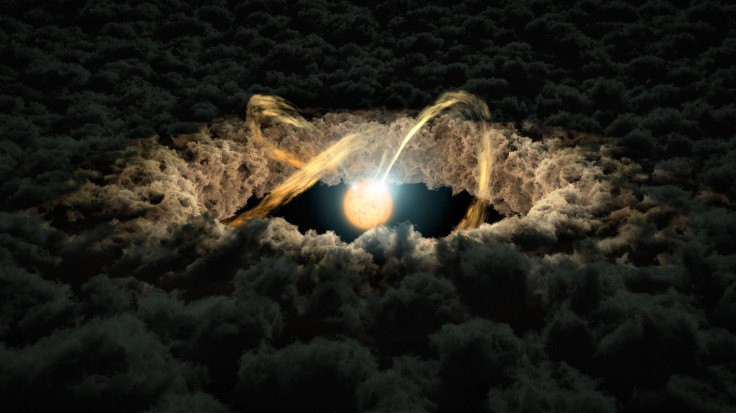Why This Triple-Star System Is Warping, Tearing Its Planet-Forming Disk

KEY POINTS
- GW Orionis is a unique star system with three stars
- Researchers have found that its planet-forming disk is warped and broken into rings
- Research teams are presenting suggestions as to what caused the disk to warp
Astronomers have found the first evidence of a multi-star system essentially tearing apart its planet-forming disk. Research teams are now suggesting possible reasons for the system's warped disk.
Most stars like our sun are born with siblings. Some have even suggested that the sun was once a part of a binary system. In a new study published in the journal Science, a team of astronomers describes a multi-star system called GW Orionis with three stars, with the inner stars, GW Ori A and B, orbiting each other with a distance of 1 astronomical unit (au) and the outer star, GW Ori C, orbiting the two inner stars at a distance of about 8 au.
In the case of our solar system, the planets are orbiting the sun in the same plane. But in multi-star systems like GW Orionis, the stars typically have orbits that are not aligned.
Models have predicted that the gravitational pull of the stars in binary or triple star systems would lead to a process called "disk-tearing" wherein the disk warps and breaks into rings. Researchers' observations using the Atacama Large Millimeter/submillimeter Array (ALMA) and the European Southern Observatory's Very Large Telescope (ESO's VLT) in Chile revealed that GW Orionis' planet-forming disk is not flat but has three separate rings, with the innermost disk being the most misaligned.
"Our images reveal an extreme case where the disc is not flat at all, but is warped and has a misaligned ring that has broken away from the disc," study lead and professor of astrophysics at the University of Exeter, Stefan Kraus, said in an ESO news release.
But despite being warped, the researchers believe the planet-forming disk may actually still form planets. They found that the inner ring actually has 30 Earth-masses of dust, which is more than enough to form planets, perhaps one that's like the fictional "Tatooine" from where misaligned twin suns can be observed.
The researchers' computer simulations seem to align with the idea that the misalignment was caused by the stars' misaligned orbits. In their simulations, the shape of the inner orbit even matched the predictions on how the disk would tear.
A separate team of researchers from an earlier study published in The Astrophysical Journal in May had suggested another possible reason for the warp. The team had also used ALMA and observed the three dust rings, with the outermost ring being the largest ever observed on planet-forming rings.
"Our simulations show that the gravitational pull from the triple stars alone cannot explain the observed large misalignment. We think that the presence of a planet between these rings is needed to explain why the disk was torn apart," study-co author of the earlier study, Nienke van der Marel of the University of Victoria, said in a news release from the National Radio Astronomy Observatory. "This planet has likely carved a dust gap and broken the disk at the location of the current inner and outer rings."
A planet has yet to be observed within the system but future studies could determine whether it does exist or is still being formed. If it is found, it will be the first ever planet to be observed in a triple star system and, it would likely have a rather unusual orbit.
© Copyright IBTimes 2025. All rights reserved.






















